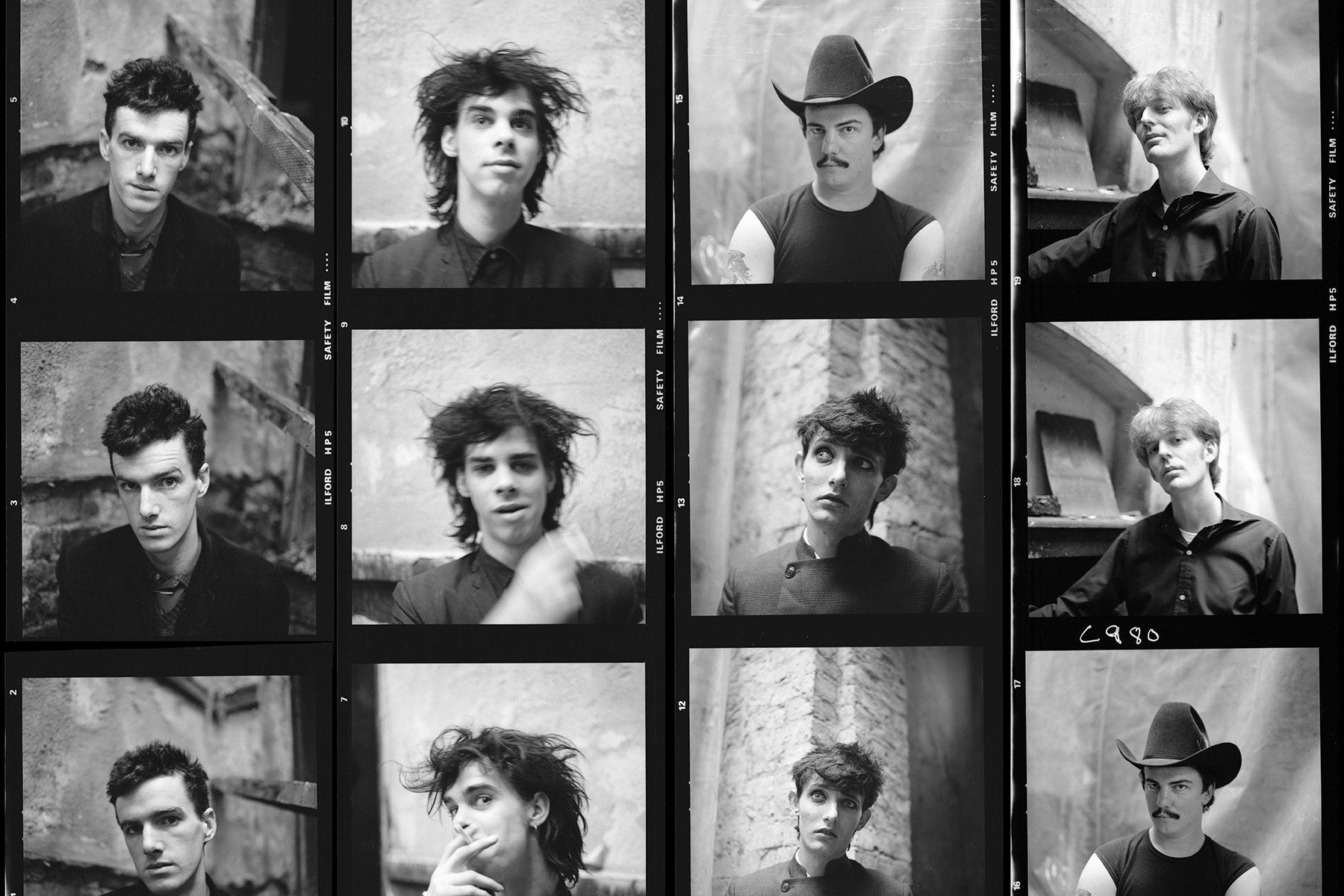Self-mythologisation is not unusual in the arts, especially in the world of pop and rock music. David Bowie was a man of many personas who was interested in Andy Warhol, and artist who spoke about himself in the third person and was just as famous for his lifestyle as he was his art. Salvador Dalí in his later years sold himself as “Dalí”. Madonna, John Lydon, Lady Gaga are avatars of metonymical exchange. It is part of the industry to whip up a certain glamour (or anti-glamour) to sell yourself. Where it wasn’t happening was in Australia. Yet, Nick Cave: the son of educated parents, and private school boy, turned himself into an icon of abject rebellion and excess, coupled with an obsessively fierce intellect. Ian White’s documentary Mutiny in Heaven: The Birthday Party takes a look at Cave’s formative years with the bands The Boys Next Door and The Birthday Party and how he, Roland S. Howard, Tracy Pew, Phill Calvert, and the ever patient Mick Harvey took themselves from Caulfield Grammar (with the exception of Howard) to St Kilda’s ‘Crystal Ballroom’ then to London, and eventually Berlin where the inevitable implosions of personalities, poverty, addiction, and exhaustion would scupper one of Australia’s rawest musical exports.
It must be mentioned that there is a deeply melancholy aspect to the documentary. Two members of The Birthday Party are dead – Howard and Pew. Although flashing on the screen only as “Nick Cave’s girlfriend,” Anita Lane (a frequent musical collaborator of Cave, Harvey, Barry Adamson, Blixa Bargeld, and more) has also passed away. While watching the documentary it is striking that any of the band survived at all. The drug and alcohol dependency and nihilism soaks through just as much as their particular brand of “intellectual sonic violence.”
Assembling recollections recorded over different periods in the band’s lives, along with archived concert footage, photography (authentic and repurposed), sections of other films (B-Movie: Lust & Sound in West-Berlin 1979-1989), and animation, White attempts to convey the chaos that was the post-punk era in Australia and internationally. At the end of the documentary Nick Cave states, “I never even found out why the band got broken up. You just go on and do something else.” It’s an eye-opening moment of self-delusion on Cave’s part as anyone watching will be wondering how it didn’t happen sooner. Cave’s restlessness, resentments, “rebel without a cause” ferocity, and generalised debauchery made him a visceral performer and hypnotic frontman – but they didn’t do anything to curb his ego. By the time the band splintered in Berlin, Howard and Cave could barely be in the same room and Calvert had been summarily fired before relocation. Blixa Bargeld moved like a shadow behind them. There seemed to be little method left in the madness – just madness.
As The Birthday Party the band played almost five hundred gigs but spent most of their time living in squats waiting for the next fix. Pew, Howard, and Cave were the heaviest drug users. As the “straight man” in the band Harvey spent a lot of time smoothing over disputes. The one time he let loose and drank himself into a stupor was in America (a market they never really cracked). Moving between countries to tour, record, and live placed enormous pressure on them all. In Australia they would go to the studio of legendary producer Tony Cohen and make a record or single. They’d then try to find distribution overseas which originally came from Ivo Watts-Russell and 4AD (later Mute records). On paper the band was “making it” and they were championed by people like John Peel, but little fiscal reward filtered through to them.
For fans of The Birthday Party, Mutiny in Heaven contains a deep treasure trove of information. The batshittery that was the video shoot for ‘Nick the Stripper’ (directed by Paul Goldman and Cave’s first collaboration with John Hillcoat) where the band forged permits, set fire to a tip, and bussed people in from a mental institution for what was a night of grotesquery and carnival insanity where real violence was a breath away. The reality of violence was part of the appeal for fans of the band. Nick was without fear: bending himself into harrowing bodily shapes – bleeding, cutting, for a kind of transcendent psychic experience of raw terror. The dirt and the dirge, the funereal and the funhouse, spectacles which evoked Hieronymus Bosch – profanity in all its forms.
Yet, through all of this there was a form of intellectualism. Cave in particular, and Howard, through their art school educations understood they were in a sideshow. How that sideshow manifested became a point of contention for the members. Howard was a precise songwriter, Cave more chaotic. Pew was a quiet intellectual who managed to get himself gaoled several times for drink driving and petty theft, but also read Plato. Before his death he went back to Monash University and studied philosophy.
Beyond the interviews with band members themselves (and the voices of people such as Lydia Lunch and Thurston Moore) there is a potted history of Australian alternative music. The Boys Next Door were originally signed by an arm of Michael Gudunski’s Mushroom Records. Other releases came out via Missing Link. Creating a Venn diagram for how influential and important The Boys Next Door and The Birthday Party were and are would take a long time. Add in The Bad Seeds and the list goes on. Just a small sample would include: The Saints (Pew played bass post The Birthday Party). Blue Ruin. These Immortal Souls. Crime and the City Solution. There is a line that leads from Magazine with Barry Adamson, through to German industrial music like Die Haut, Einstürzende Neubauten, back again to The Triffids, The Wreckery, Dirty Three. Extend it further again and it includes Sam Sejavka, Richard Lowenstein, Michael Hutchence, and Kylie Minogue. Adding another root to the rhizome is Kid Congo Powers who moves the connection to America and The Gun Club, The Cramps, and of course, Lydia Lunch.
Ian White’s documentary can’t contain everything. What it does contain is a frenetic portrait of a band that drew “No line between the performance and the people.” Who sought to speak a new language in rock – one of sin, punishment, and perversion. Cave who sought to piss people off and frighten them only to find that circling back to him. Cave a man obsessed with art, literature, and religion – who took his cues from Johnny Cash and Faulkner, Arthur Rimbaud, jazz, blues and swamp rock. Then the equally intelligent and artistic Roland S. Howard with his built-in fragility becoming more pronounced as he suffered severe malnutrition. The animated sections which relate the band’s bizarre history are stylised a la Reinhard Kleist and are mixed with Cave’s handwriting and art.
For a band that only produced four studio albums and collected EPs, The Birthday Party remain one of the most terrifying and eclectic acts to ever emerge from Australia. Too smart and too stupid for their own good, they were always going to “drive off a cliff.” They were musical pyromaniacs wanting to burn down everything that made Australia seem small and disconnected. It’s little wonder that they ended up recording in a former Nazi ballroom. Desiring to hiss and spit at conformity and complacence comes at an immense cost. Ian White’s Mutiny in Heaven proves that the battle cry of “Hands up who wants to die!” from ‘Sonny’s Burning’ wasn’t just a lyric for the band but a dare they were issuing the audience and themselves. For all their pretensions (and there were many) The Birthday Party managed to be excruciatingly real. The junkyard was overflowing, the funeral dirge playing, and the carnival came to town and then morphed into new variations – some got to play along while others were left in the dusty wake.
Director: Ian White
Featuring: Phill Calvert, Nick Cave, Mick Harvey
Producer: Bill Lord
Editor: Aaron J. March



